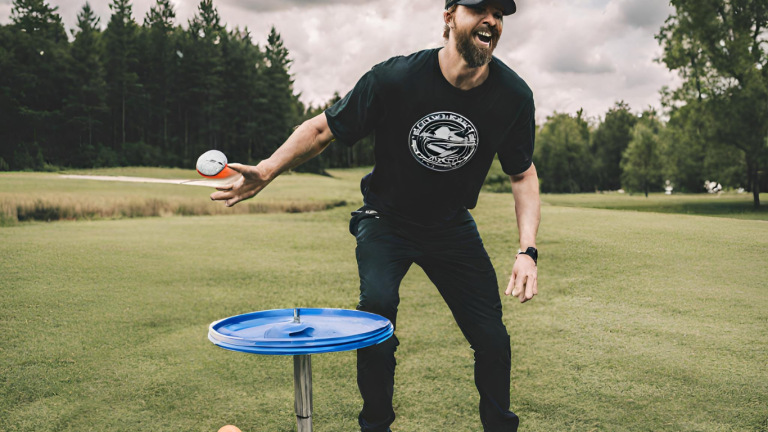What Are Flight Numbers what do they mean and a better approach? Demystifying Flight Numbers & Finding Your Perfect Disc
Confused by Flight Numbers? Learn what they mean & discover a better approach! What are Flight Numbers? what do they mean and a better approach? Remember that feeling of standing in a disc golf store, surrounded by shelves of colorful discs, each stamped with mysterious numbers? You might have picked up a driver labeled “12, 5, -2, 3” and wondered, “What does this even mean? How does it help me choose the right disc?!
Fear not, fellow disc golfers! Those numbers, known as flight numbers, are an attempt to describe a disc’s flight path. But are they the key to unlocking disc golf mastery? Let’s delve into the world of flight numbers, explore their limitations, and discover a more personalized approach to finding your perfect disc.
What are Flight Numbers?
Ever felt lost in the sea of plastic at a disc golf store, surrounded by an alphabet soup of numbers on each disc? You’re not alone! Those numbers, called flight numbers, are supposed to tell you how a disc flies, but for many beginners, they just add to the confusion.
Don’t worry, though! This guide will crack the code of flight numbers, explain what they mean, and, more importantly, offer a better approach to finding the perfect disc for your throws. Let’s ditch the number overload and focus on what truly matters: your game!
What Are Flight Numbers? Demystifying the Code and Finding Your Perfect Disc
Remember that first foray into the disc golf store? Walls lined with vibrant discs, each one seemingly speaking its own language of cryptic numbers. I vividly recall my own experience, standing there bewildered by the seemingly random digits stamped on every disc. “9, 5, 0, 2,” I thought, “what in the world does this even mean? How does it help me find the right disc for me?”
The Problem of Flight Number Confusion:
This confusion is a common experience for many beginner disc golfers. Flight numbers, intended to be a helpful guide to a disc’s flight path, often leave them feeling lost in translation. The numbers themselves can be perplexing, and their precise meaning can seem elusive. This can lead to frustration and ultimately, poor disc selection.
Introducing a Better Approach:
While flight numbers do offer some insight, relying solely on them can hinder your progress. This guide will unveil the meaning behind each number, but more importantly, it will introduce a better approach to finding the perfect disc for your individual throwing style and preferences. Let’s delve deeper into the world of flight numbers, understand their limitations, and discover a more personalized path to disc selection success!
Breakdown of Flight Numbers:
Flight numbers are a system used by disc manufacturers to represent the anticipated flight characteristics of a disc. These numbers aim to describe the disc’s speed, glide, turn, and fade. Think of them as a roadmap for how the disc might behave in ideal conditions, thrown with proper technique.
Understanding the Numbers:
Let’s break down each number and explore its meaning:
Speed (1-14):
This number indicates the disc’s potential airborne distance. It essentially reflects how fast the disc can travel through the air. Higher numbers represent faster discs, capable of covering greater distances when thrown with proper technique. Imagine a disc with a speed rating of 14 like a sports car – powerful and built for speed. Conversely, a disc with a speed rating of 3 might be compared to a reliable family car – dependable and easy to control.
Glide (1-7):
This number reflects the disc’s ability to maintain lift during flight. Higher glide discs stay airborne for longer, potentially resulting in greater distance, especially in tailwinds. Think of a disc with high glide as a glider plane – it stays aloft with minimal effort. A disc with low glide, on the other hand, might be compared to a dart – it cuts through the air with a more direct path.
Turn (0 to -5):
This number describes the disc’s tendency to turn right (for right-handed backhand throws) during the initial part of its flight. Higher negative numbers indicate more turn, while positive numbers and zero suggest straighter flight paths. Imagine a disc with a high negative turn rating as a playful puppy – it might veer off course a bit initially before settling into its flight path. Conversely, a disc with a positive turn or zero turn rating might be compared to a well-trained dog – it stays on a more predictable line.
Fade (0-5):
This number represents the disc’s tendency to fade left (for right-handed backhand throws) towards the end of its flight. Higher fade numbers indicate a more pronounced leftward turn at the end of the flight path. Think of a disc with high fade as a boomerang – it eventually curves back towards the thrower. A disc with low fade, on the other hand, might be compared to a jet airliner – it maintains a straighter trajectory throughout its flight.
You May Also Like To See: How to Start a Disc Golf League?
Important Note:
It’s crucial to remember that flight numbers are estimates and can be influenced by various factors:
Throwing technique:
An experienced thrower can significantly impact a disc’s flight path regardless of its flight numbers. Imagine a skilled driver taking a corner – they can control the car’s movement even at high speeds. Similarly, a seasoned disc golfer can manipulate a disc’s flight for a desired outcome.
Disc wear:
As a disc gets worn in, its flight characteristics can change, affecting its turn and fade. Over time, a disc might become more understable (more likely to turn) as the plastic loses its grip.
Wind conditions:
Wind can significantly alter a disc’s flight path, making flight numbers less reliable. Imagine throwing a Frisbee on a windy day – its path becomes unpredictable. Wind can similarly affect a disc’s flight, making flight numbers less accurate in non-ideal conditions.
A Better Approach to Choosing Discs (Your Unique Insight):
While flight numbers offer a glimpse into a disc’s potential, they shouldn’t be the sole deciding factor when choosing your discs. Here’s a different approach, informed by my own experiences, that can help you find discs that truly match your game:
Focus on Throwing Technique:
Before diving into the world of flight numbers, prioritize developing proper throwing technique. Think of it like this: Even the most high-performance sports car won’t reach its full potential if the driver behind the wheel doesn’t know how to handle it. The same applies to disc golf. Mastering a smooth, controlled throw will significantly impact your disc’s flight path, regardless of its flight ratings.
Instead of solely relying on numbers to choose a disc that might “fix” your throws, focus on refining your form. Online resources, instructional videos, and even lessons from experienced players can be invaluable in this journey. By improving your technique, you’ll gain the ability to manipulate various discs to achieve different flight patterns, making you a more versatile and adaptable player.
Consider Playing Style and Disc Type:
Once you have a solid foundation in throwing technique, consider your playing style and the specific type of disc you need. Are you a beginner aiming for accuracy with short-range shots? A mid-range disc with a neutral flight path might be a better fit than a high-speed driver. Do you bomb long drives down the fairway? A high-speed driver with a controlled fade could be your weapon of choice.
Remember, different disc types serve different purposes. Drivers prioritize distance, mid-range discs offer control and accuracy for approach shots, and putters excel in short-range precision and putting. Understanding these roles and aligning them with your playing style is crucial for selecting the right tools for the job.
Recommendation: Try Discs!
Here’s the real kicker: the best way to find your perfect discs is to simply try them out. Head to a local disc golf store or visit a course with a “discing bin” where you can test throw various discs. Feel their weight and rim size in your hand. Ask experienced players for recommendations and see if they’ll let you try their discs.
This hands-on approach allows you to experience the feel and flight characteristics of different discs firsthand. You might be surprised to discover that a particular disc, despite its flight numbers, feels incredibly comfortable and performs exceptionally well for your throwing style.
Highlighting Personal Experience:
I vividly remember my early days in disc golf, armed with my beginner’s set and a head full of flight number knowledge. I meticulously chose a driver with a seemingly perfect combination of speed, glide, turn, and fade, expecting it to launch bombs. However, reality was far from ideal. The disc felt awkward in my hand, and my throws lacked control. It wasn’t until I focused on improving my technique and trying out different discs that I discovered a mid-range disc that fit my hand perfectly and allowed me to develop my game.
This personal experience solidified my belief that a better approach to disc selection involves focusing on technique, understanding disc types and your playing style, and most importantly, trying out different discs to find what feels comfortable and performs well for you. Remember, the perfect disc isn’t just about numbers; it’s about finding the one that becomes an extension of your throwing style and helps you conquer the course.
Conclusion:
While flight numbers offer a starting point, don’t let them dictate your disc selection journey. Focus on mastering your throwing technique, consider your playing style and disc types, and most importantly, try out different discs to find your perfect match. Remember, the best disc is the one that feels comfortable and performs well for you, not just on paper but on the course!
FAQs
Q1. What are flight numbers?
Answer:
Flight numbers are a system used by disc manufacturers to represent a disc’s potential speed, glide, turn, and fade.
Q2. Should I choose a disc solely based on flight numbers?
Answer:
No, flight numbers are estimates and can be influenced by factors like your throwing technique and wind conditions. Focus on technique and trying discs to find a good fit.
Q3. What’s the best way to choose a disc?
Answer:
Develop your throwing technique, understand disc types (drivers, mid-range, putters), and try various discs to find what feels comfortable and performs well for you.







